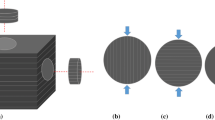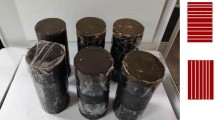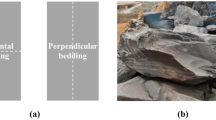Abstract
The anisotropic mechanical and acoustic emission characteristics of oil shale from room temperature to 600 °C were studied using a real-time high-temperature uniaxial rock testing machine independently developed by the Taiyuan University of Technology and an acoustic emission test system. The results indicate that the elastic modulus and compressive strength of the oil shale perpendicular to bedding direction first decrease and then increase with increasing temperature from room temperature to 600 °C and reach their minimum values at 400 °C, showing the characteristics of first softening and then hardening. The threshold temperature of oil shale mechanical parameters in the direction perpendicular to bedding direction is 400 °C. The strength of oil shale parallel to the bedding direction decreases sharply at 100 and 400 °C due to free water evaporation and kerogen pyrolysis, respectively. The threshold temperatures of oil shale mechanical parameters parallel to bedding direction are 100 and 400 °C. The micro-SEM and CT analyses conclude that the transformation of the mineral structure changes the mechanical parameters of oil shale perpendicular to bedding, and the evolution of the fracture structure dominates the change in the mechanical parameters of oil shale parallel to bedding. The results of this study can provide a theoretical data basis for elucidating the in situ pyrolysis of oil shales.


















Similar content being viewed by others
References
Aleklett K, Höök M, Jakobsson K, Lardelli M, Snowden S, Söderbergh B (2010) The peak of the oil age-analyzing the world oil production reference scenario in world energy outlook. Energ Policy 38(3):1398–1414
Amadei B (1996) Importance of anisotropy when estimating and measuring in situ stresses in rock. Int J Rock Mech Min 33(3):293–325
ASTM (2013) Standard test methods for compressive strength and elastic moduli of intact rock core specimens under varying states of stress and temperatures, Designation: D7012-13. ASTM International, West Conshohocken
Bai FT, Sun YG, Liu Y, Guo M (2017) Evaluation of the porous structure of huadian oil shale during pyrolysis using multiple approaches. Fuel 187:1–8
Bi JL (2016) Experimental study on fracture characteristics of oil shale under thermal-mechanical coupling field. Taiyuan University of Technology (in Chinese)
Cho JW, Kim H, Jeon S, Min KB (2012) Deformation and strength anisotropy of Asan gneiss, Boryeong shale, and Yeoncheon schist. Int J Rock Mech Min 50:158–169
Closmann PJ, Bradley WB (1979) The effect of temperature on tensile and compressive strengths and Young’s modulus of oil shale. SPe J 19(05):301–312
Eseme E, Urai JL, Krooss BM, Littke R (2007) Review of mechanical properties of oil shales: implications for exploitation and basin modelling. Oil Shale 24(2):159–174
Feng LY, Li JC, Pang XQ (2008) China’s oil reserve forecast and analysis based on peak oil models. Energy Policy 36(11):4149–4153
Fereidooni D, Khanlari GR, Heidari M, Sepahigero AA, Kolahi-Azar AP (2016) Assessment of inherent anisotropy and confining pressure influences on mechanical behavior of anisotropic foliated rocks under triaxial compression. Rock Mech Rock Eng 49(6):2155–2163
Fletcher TH, Gillis R, Adams J, Hall T, Mayne CL, Solum MS, Pugmire RJ (2014) Characterization of macromolecular structure elements from a green river oil shale, II. Characterization of pyrolysis products by13C NMR, GC/MS, and FTIR. Energy Fuel 28(5):2959–2970
Gaede O, Karpfinger F, Jocker J, Prioul R (2012) Comparison between analytical and 3D finite element solutions for borehole stresses in anisotropic elastic rock. Int J Rock Mech Min Sci 51:53–63
Geng YD (2018) Experimental study on the physical and mechanical properties of oil shale during in-situ fracturing and pyrolysis. Taiyuan University of Technology (in Chinese)
Geng YD, Liang WG, Liu J, Cao MT, Kang ZQ (2017) Evolution of pore and fracture structure of oil shale under high temperature and high pressure. Energy Fuel 31(10):10404–10413
Guo S, Zhu R (1995) The composition of Fushun and Maoming shale oils. Fuel 74(11):1719–1721
Heng S, Guo Y, Yang C, Daemen JJ, Li Z (2015) Experimental and theoretical study of the anisotropic properties of shale. Int J Rock Mech Min 74:58–68
Heuze FE (1983) High-temperature mechanical, physical and thermal properties of granitic rocks—a review. Int J Rock Mech Min 20(1):3–10
Hu SC, Tan YL, Zhou H, Guo WY, Hu WD, Meng FZ (2017) Impact of bedding planes on mechanical properties of sandstone. Rock Mech Rock Eng 50(8):2243–2251
Jia LC, Chen M, Jin Y, Jiang HL (2017) Numerical simulation of failure mechanism of horizontal borehole in transversely isotropic shale gas reservoirs. J Nar Gas Sci Eng 45:65–74
Jiang XM, Han X, Cui ZG (2007) New technology for the comprehensive utilization of Chinese oil shale resources. Energy 32(5):772–777
Kang ZQ (2008) Physical principle and numerical analysis of oil shale development using in-situ conversion process technology. Acta Petrol Sin 29(4):592–595
Kang ZQ, Yang D, Zhao YS, Hu YQ (2011) Thermal cracking and corresponding permeability of Fushun oil shale. Oil Shale 28(2):273
Kim H, Cho JW, Song I, Min KB (2012) Anisotropy of elastic moduli, P-wave velocities, and thermal conductivities of Asan Gneiss, Boryeong Shale, and Yeoncheon Schist in Korea. Eng Geol 147:68–77
Lee H, Ong SH, Azeemuddin M, Goodman H (2012) A wellbore stability model for formations with anisotropic rock strengths. J Pet Sci Eng 96–97:109–119
Li SY (2012) The developments of Chinese oil shale activities. Oil Shale 9(2):101–102
Li Y, Weijermars R (2019) Wellbore stability analysis in transverse isotropic shales with anisotropic failure criteria. J Petrol Sci Eng 176:982–993
Liu K, Sheng JJ (2018) Experimental study of the effect of stress anisotropy on fracture propagation in Eagle Ford shale under water imbibition. Eng Geol L249:13–22
Liu DY, Li HCH, Zhang C, Wang QT, Peng P (2019) Experimental investigation of pore development of the Chang 7 member shale in the Ordos basin under semi- closed high-pressure pyrolysis. Mar Petrol Geol 99:17–26
Liu Z, Sun Y, Guo W, Li Q (2020) Reservoir-scale study of oil shale hydration swelling and thermal expansion after hydraulic fracturing. J Petrol Sci Eng 195:107619
Masri M, Sibai M, Shao JF, Mainguy M (2014) Experimental investigation of the effect of temperature on the mechanical behavior of Tournemire shale. Int J Rock Mech Min 70:185–191
Meier T, Rybacki E, Backers T, Dresen G (2015) Influence of bedding angle on borehole stability: a laboratory investigation of transverse isotropic oil shale. Rock Mech Rock Eng 48(4):1535–1546
Ong SH, Roegiers J-C (1993) Influence of anisotropies in borehole stability. Int J Rock Mech Min Sci Geomech Abstr 30(7):1069–1075
Pei S, Wang Y, Zhang L, Hu L, Cui GD, Zhang PF, Ren SR (2018) An innovative nitrogen injection assisted in-situ conversion process for oil shale recovery: Mechanism and reservoir simulation study. J Petrol Sci Eng 171:507–515
Perera MSA, Ranjith PG, Viete DR (2013) Effects of gaseous and super-critical carbon dioxide saturation on the mechanical properties of bituminous coal from the Southern Sydney Basin. Appl Energy 110:73–81
Saif T, Lin Q, Bijeljic B, Blunt MJ (2017) Microstructural imaging and characterization of oil shale before and after pyrolysis. Fuel 197:562–574
Saif T, Lin Q, Gao Y, Al-Khulaifi Y, Marone F, Hollis D (2019) 4D in situ synchrotron X-ray tomographic microscopy and laser-based heating study of oil shale pyrolysis. Appl Energy 235:1468–1475
Saroglou C, Kallimogiannis V (2017) Fracturing process and effect of fracturing degree on wave velocity of a crystalline rock. J Rock Mech Geotech 9(5):797–806
Solum MS, Mayne CL, Orendt AM, Pugmire RJ, Adams J, Fletcher TH (2014) Characterization of macromolecular structure elements from a Green River Oil Shale. I. Extracts. Energy Fuel 28(1):453–465
Stockton E, Leshchinsky BA, Olsen MJ, Evans TM (2019) Influence of both anisotropic friction and cohesion on the formation of tension cracks and stability of slopes. Eng Geol 249:31–44
Sun Y, Bai F, Liu B, Liu B, Guo M, Guo W (2014) Characterization of the oil shale products derived via topochemical reaction method. Fuel 115(1):338–346
Tanaka PL, Yeakel JD, Symington WA, Spiecker PM, Del Pico M., Thomas MM, Sullivan KB, Stone, MT (2011) Plan to test Exxon Mobils in situ oil shale technology on a proposed RD&D lease. 31st Oil Shale Symposium, Colorado School of Mines, 17–19, Colorado, USA
Thigpen L (1979) Vertical stress distribution in oil-shale aggregate columns during retorting. SPe J 19(02):97–106
Tiwari P, Deo M, Lin C, Miller JD (2013) Characterization of oil shale pore structure before and after pyrolysis by using x-ray micro ct. Fuel 107:547–554
Vinegar H (2016) Shell's in-situ conversion process. 26th Oil Shale symposium, Colorado, 16–19
Wang Q, Liu HP, Sun BZ, Li SH (2009) Study on pyrolysis characteristics of huadian oil shale with isoconversional method. Oil Shale 26(2):148–216
Wang J, Feng L, Steve M, Tang X, Gail TE, Mikael H (2015) China’s unconventional oil: a review of its resources and outlook for long-term production. Energy 82:31–42
Wang G, Yang D, Zhao Y, Kang Z, Zhao J, Huang X (2019) Experimental investigation on anisotropic permeability and its relationship with anisotropic thermal cracking of oil shale under high temperature and triaxial stress. Appl Therm Eng 146:718–725
Xu L (2015) Experiment and numerical simulation study on acoustic emission characteristics during cracking process of Shale. Chongqing University
Yang L, Ge H, Shen Y, Zhang J, Yan W, Wu S (2015) Imbibition inducing tensile fractures and its influence on in-situ stress analyses: a case study of shale gas drilling. J Nat Gas Sci Eng 26:927–939
Yang D, Wang G, Kang Z, Zhao J, Lv Y (2020) Experimental investigation of anisotropic thermal deformation of oil shale under high temperature and triaxial stress based on mineral and micro-fracture characteristics. Nat Resour Res 29:3987–4002
Yuan JL, Deng JG, Tan Q, Yu BH, Jin XC (2013) Borehole stability analysis of horizontal drilling in shale gas reservoirs. Rock Mech Rock Eng 46:1157–1164
Zhang Y, Sun Q, Li J, Zhang W (2015) Pore and mechanical characteristics of high-temperature baked clay. Chin J Rock Mech Eng 34(7):1480–1488 ((in Chinese))
Zhang CL, Armand G, Conil N, Laurich B (2019) Investigation on anisotropy of mechanical properties of Callovo-Oxfordian claystone. Eng Geol 251:128–145
Zhao J (2014) Experimental study on the microscopic characteristics and mechanical property of oil shale under high temperature & three-dimensional stress. Taiyuan University of Technology (in Chinese)
Funding
This study was funded by the Natural Science Foundation of China (11772213), National Key Research and Development Program of China (2019YFA0705501), Key R & D and promotion projects in Henan Province (212102310010) and Postdoctoral Research Foundation of China (2021M690918).
Author information
Authors and Affiliations
Corresponding author
Ethics declarations
Conflict of interest
We declare no conflicts of interest.
Additional information
Publisher's Note
Springer Nature remains neutral with regard to jurisdictional claims in published maps and institutional affiliations.
Rights and permissions
About this article
Cite this article
Wang, G., Yang, D., Liu, S. et al. Experimental Study on the Anisotropic Mechanical Properties of Oil Shales Under Real-Time High-Temperature Conditions. Rock Mech Rock Eng 54, 6565–6583 (2021). https://doi.org/10.1007/s00603-021-02624-7
Received:
Accepted:
Published:
Issue Date:
DOI: https://doi.org/10.1007/s00603-021-02624-7




